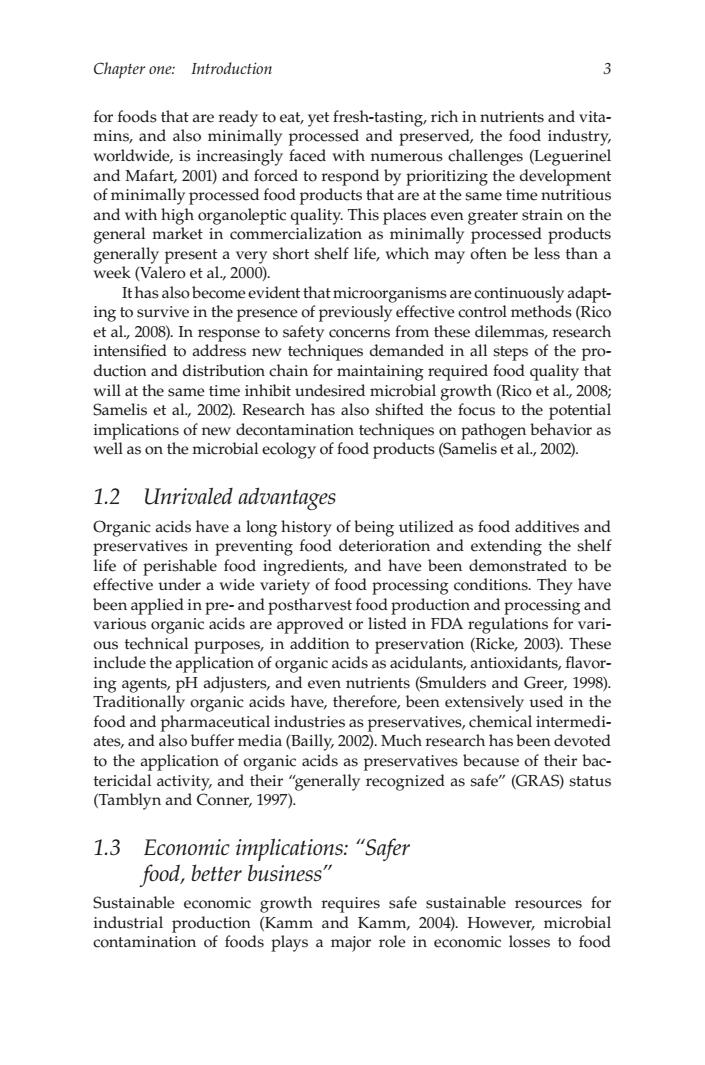正在加载图片...

Chapter one:Introduction 3 for foods that are ready toeat,yet fresh-tasting,richin mins,and also minimally processe and preservec worldwide,is increasingly faced with numerous challenges(Leguerinel and Mafart,2001)and forced to respond by prioritizing the development of minimally processed food products that are at the same time nutritious and with high organoleptic quality.This places even greater strain on the general market in commercialization as minimally rocessed products &k y short shelf life,which may often be less than et al.2000) It has also omeevident that microorga s are c ntinu usly ing to survive in the presence of previously effective control methods(Ricc et al,2008).In response to safety concerns from these dilemmas,research intensified to address new techniques demanded in all steps of the pro duction and distribution chain for maintaining required food quality that will at the same time inhibit undesired microbial growth(Rico et al.,2008 Samelis et al 2002).Research has also shifted the focus to the potential tech ecology of food product s (S elis 82L2002 or as 1.2 Unrivaled advantages Organic acids have a long history of being utilized as food additives and preservatives in preventing food deterioration and extending the shelf life of perishable food ingredients,and have been demonstrated to be effective under a wide variety of food processing conditions.They have been appliedand postharvest food production and processingand cids ar ved or listed in FDA ,1 app ns fo ses in addi 10 o pres Ricke ,2003). hes on of organic acids as ac ants,flavo ing agents,pH adjusters,and even nutrients(Smulders and Greer,1998) Traditionally organic acids have,therefore,been extensively used in the food and pharmaceutical industries as preservatives,chemical intermedi- ates,and also buffer media(Bailly,2002).Much research has been devoted to the application of organic acids as preservatives because of their bac- tericidal activity and their"generally recognized as safe"(GRAS)status (Tamblyn and Conner,1997). 1.3 Economic implications:"Safer food,better business" Sustainable requres safe sustainable industrial production (Kamm and Kamm,2004).How ever,microbia contamination of foods plays a major role in economic losses to food Chapter one: Introduction 3 for foods that are ready to eat, yet fresh-tasting, rich in nutrients and vitamins, and also minimally processed and preserved, the food industry, worldwide, is increasingly faced with numerous challenges (Leguerinel and Mafart, 2001) and forced to respond by prioritizing the development of minimally processed food products that are at the same time nutritious and with high organoleptic quality. This places even greater strain on the general market in commercialization as minimally processed products generally present a very short shelf life, which may often be less than a week (Valero et al., 2000). It has also become evident that microorganisms are continuously adapting to survive in the presence of previously effective control methods (Rico et al., 2008). In response to safety concerns from these dilemmas, research intensified to address new techniques demanded in all steps of the production and distribution chain for maintaining required food quality that will at the same time inhibit undesired microbial growth (Rico et al., 2008; Samelis et al., 2002). Research has also shifted the focus to the potential implications of new decontamination techniques on pathogen behavior as well as on the microbial ecology of food products (Samelis et al., 2002). 1.2 Unrivaled advantages Organic acids have a long history of being utilized as food additives and preservatives in preventing food deterioration and extending the shelf life of perishable food ingredients, and have been demonstrated to be effective under a wide variety of food processing conditions. They have been applied in pre- and postharvest food production and processing and various organic acids are approved or listed in FDA regulations for various technical purposes, in addition to preservation (Ricke, 2003). These include the application of organic acids as acidulants, antioxidants, flavoring agents, pH adjusters, and even nutrients (Smulders and Greer, 1998). Traditionally organic acids have, therefore, been extensively used in the food and pharmaceutical industries as preservatives, chemical intermediates, and also buffer media (Bailly, 2002). Much research has been devoted to the application of organic acids as preservatives because of their bactericidal activity, and their “generally recognized as safe” (GRAS) status (Tamblyn and Conner, 1997). 1.3 Economic implications: “Safer food, better business” Sustainable economic growth requires safe sustainable resources for industrial production (Kamm and Kamm, 2004). However, microbial contamination of foods plays a major role in economic losses to food